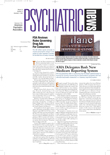A new meta-analysis of clinical-trials data appears to confirm a small but statistically significant increase in risk of death associated with the use of second-generation (or “atypical”) antipsychotic medications (SGAs) in elderly patients who have dementia.
SGAs have increasingly been prescribed off label in recent years to patients with dementia to help calm agitation and aggression or treat delusions and hallucinations, as well as other behavioral disturbances commonly associated with various forms of dementia, including Alzheimer's disease.
Concern over the drugs' use in frail, elderly patients has been steadily growing, however, and this past April the U.S. Food and Drug Administration ordered revisions to the labels of all SGAs. Each of the drugs' labels now includes language on the increased risk of death in elderly demented patients within the labels' black-box warnings (Psychiatric News, May 6).
The new meta-analysis, completed by investigators at the University of Southern California (USC), appeared in the October 19 Journal of the American Medical Association. The meta-analysis was funded with grants from the Alzheimer's Disease Centers of California and the University of Southern California Alzheimer's Disease Research Center.
The report's lead author, Lon Schneider, M.D., M.S., a professor of psychiatry and behavioral sciences at USC's Keck School of Medicine, is also the coprincipal investigator (with the University of Rochester's Pierre Tarriot, M.D.) of the National Institute of Mental Health's Clinical Antipsychotic Trials of Intervention Effectiveness–Alzheimer's Disease (CATIE-AD) study.
CATIE-AD was designed to look at the effectiveness and safety of using antipsychotic medications to control the behavioral disturbances associated with dementia in “real-world” practice settings. Although data collection has been completed in CATIE-AD, results have yet to be published. Researchers who conducted NIMH's companion CATIE-Schizophrenia study reported primary results in September (Psychiatric News, October 21).
In the current report, Schneider and his colleagues electronically searched MEDLINE from 1966 to April 2005 and the Cochrane Controlled Trials Register (January 1, 2005). In addition, they reviewed conference proceedings, abstracts, and poster presentations (1999 through April 2005) from geriatric medicine, psychiatric, neurological, and geriatric psychiatry meetings. Information was also requested from pharmaceutical manufacturers and the FDA.
In all, the team identified and analyzed 15 clinical trials in which the SGAs aripiprazole (Abilify), olanzapine (Zyprexa), quetiapine (Seroquel), or risperidone (Risperdal) were compared with placebo. (One study included both olanzapine and risperidone.) The studies encompassed 3,353 patients who received one of the four SGAs and 1,757 patients who received placebo.
During the active-treatment phase of a clinical trial of patients taking one of the four drugs, 118 deaths occurred, compared with 40 deaths among those on placebo. This difference was statistically significant (p=0.02). Patients taking an SGA were 1.54 times more likely to die (from any cause) than those patients assigned to receive placebo in the clinical trials studied. While available details were not plentiful, most of the reported deaths were cardiovascular in origin or from infections such as pneumonia.
When Schneider and his colleagues analyzed all the data they had available to estimate patients' total exposure to either drug or placebo (that is, dose as well as duration of drug/placebo therapy), they found that the overall relative risk of death was 1.65 times more likely in those taking drug compared with those taking placebo.
In this pooled, total-exposure analysis, each of the individual medications was associated with an increased relative risk of death from any cause, compared with placebo. However, the risk varied among the drugs, with the highest relative risk of death associated with olanzapine (RR=2.31) and the lowest with risperidone (RR=1.35). However, while the overall increase was highly statistically significant (p=0.003), none of the relative risks calculated for the individual medications reached statistical significance.
“Although the findings were consistent from trial to trial and from drug to drug,” Schneider and his coauthors concluded in their JAMA report, “It is only when all trials are combined that a statistically significant effect is found. No drug is individually responsible for the effect, but rather each contributes to the overall effect.”
In an editorial accompanying the report, Peter Rabins, M.D., M.P.H., and Constantine Lyketsos, M.D., M.H.S., both in the department of psychiatry and behavioral sciences at Johns Hopkins University School of Medicine, noted,“ The results do not contraindicate the use of antipsychotic drugs in the treatment of patients with dementia,” but rather, they write, “the results change the risk-benefit analysis such that antipsychotic drugs should be used only when there is an identifiable risk of harm to the patient or others, when the distress caused by the symptoms is significant, or when alternate therapies have failed, and symptom relief would be beneficial.”
Rabins and Lyketsos also noted the difficulties that Schneider and his colleagues encountered in trying to identify all available data on the use of antipsychotics in elderly demented patients. Similar challenges have been encountered with research efforts involving other drug classes, they added.
“Because there is a significant likelihood that rare events will not be identified in the two [studies] required by the FDA for approval,” Rabins and Lyketsos wrote, “the FDA must put more effort into formal post-marketing surveillance” and require public registry of all clinical-trials data.
JAMA 2005 294 1934
JAMA 2005 294 1963
